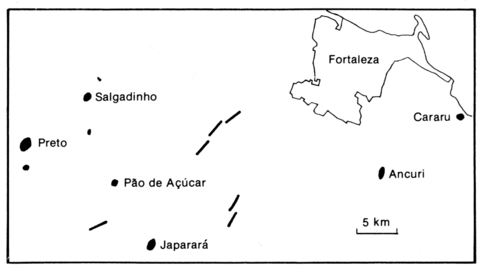stripes
An alkaline province consisting of a number of necks (Pao deAcucar, Salgadinho, Japarara), plugs (Ancuri, Gangorra, Pocao), a dome (Cararu), a concentric structure (Preto) and an associated suite of dykes is situated in the Fortaleza area. The necks are up to 2 km in diameter and form conical hills, the highest, Japarara, reaching 470 m. The more easterly occurrences of Cararu and Ancuri are surrounded by Quaternary and Tertiary deposits, respectively, but the others are emplaced in gneisses of the Caico complex which they metamorphose. Ancuri and Cararu consist of amphibole-aegirine phonolite, with abundant stilbite as aggregates and in fractures on Cararu. Xenoliths of igneous rocks, including some described as fourchites, and metamorphic rocks are abundant. Major and trace element analyses are available (Rao and Sial, 1972; Vandoros and Oliveira, 1968). Preto consists of phonolitic trachyte with K-feldspar, aegirine, nepheline, analcime, sodalite and opaques. A small plug immediately south of Preto also contains cancrinite, aegirine-augite, carbonate, leucoxene, a little biotite and a sodic amphibole. The Pao de Acucar phonolitic trachyte is highly vesicular and amygdaloidal and comprises nepheline and aegirine phenocrysts, K-feldspar, analcime, sodalite, opaques, cancrinite, carbonate and barkevikite. Blocks of tuff occur in Pao de Acucar and Cararu. They have a similar mineralogy to the enclosing rocks, but also include basalt. The dykes are both simple and multiple, up to 15 m thick, and trend essentially northeast-southwest. They are trachytes and phonolitic trachytes, sometimes with blue sodalite phenocrysts. A general review of the geochemistry of the province is given by Guimaraes et al. (1982) who also give analyses of pyroxenes and amphiboles. 25 km south of Pentecoste (approx. 100 km west-southwest of Fortaleza) blocks of porphyritic essexite occur over an area 100x200 m and probably derive from a northeast-southwest aligned dyke cutting Caico gneiss. It is a mesocratic rock with phenocrysts of Ti-augite and olivine in a matrix of andesine, sanidine, nepheline, cancrinite and accessories. There is a further occurrence some 12 km to the east.
BRAGA, A.P.G., PASSOS, C.A.R., SOUZA, E.M., FRANCA, J.B., MEDEIROS, M.F. and ANDRADA, A. 1977. Projeto Fortaleza (Relatorio Final). DNPM-CPRM, 1: 180 pp.
GUIMARAES, I.P., SIAL, A.N. and FILHO, A.F.S. 1982. Petrologia e geoquimica da provincia alcalina Terciaria Fortaleza, Ceara. Anais Congresso Brasileira de Geologia, 32 (2): 577-88.
RAO, A.B. and SIAL, A.N. 1972. Observations on alkaline plugs near Fortaleza City, Ceara State, Brazil. 24th International Geological Congress, Montreal, 14: 56-61.
VANDOROS, E. and OLIVEIRA, M.A.F. de, 1968. Sobre o fonolito de Mecejana, Ceara. Anais Academia Brasileira de Ciencias, 40: 203-6

